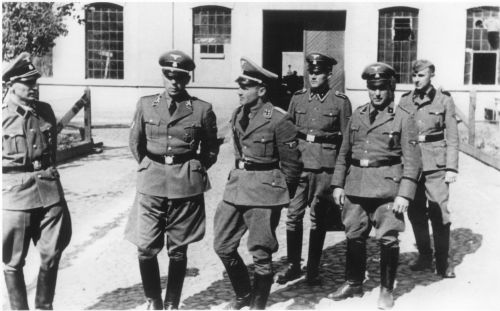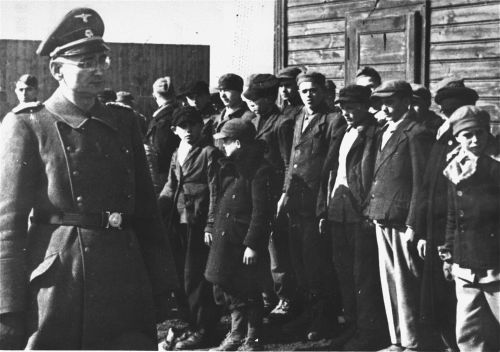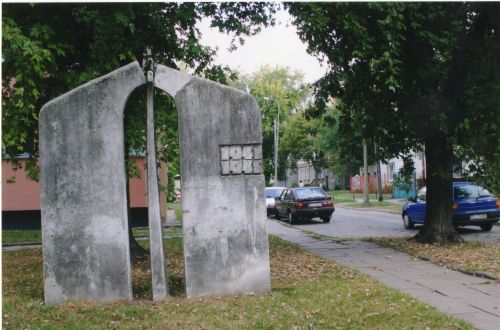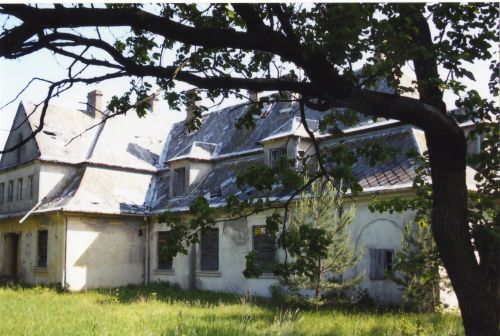Litzmannstadt - Jugendlager

Otto Hofmann Head of the Race and Settlement Main Office visits the camp in 1943 (USHMM)
Between December 1, 1942, and January 18, 1945, the Reich Criminal Police Office operated a camp for Polish Juveniles inside the Lodz ghetto. It was designated the Polish Youth Custody Camp of the Security Police in Litzmannstadt, it was administratively related to the German 'youth protection camps.' It was directed by the Criminal Police, it deployed forced labour for the SS- Business Administration Main Office (WVHA) Group D.
Two months after the German invasion of Poland, the RSHA commenced an arrest campaign against Polish juvenile delinquents. To this end Arthur Nebe, in charge of Amt V of the Reich Main Security Office (RSHA), called for the establishment of a Jugendschutzlager in the Old Reich and the newly incorporated territories of Poland. Although he ordered the Kriminalpolizeistelle Lodsch to establish a Polish youth camp on April 1, 1940, his order took more than two years to implement. The delay was partly attributable to the imposition of German administration in the annexed territories, particularly of the welfare authorities, but space accommodation for the juveniles also played a role. Litzmannstadt's Kripo and mayor's office repeatedly complained about rising youth crime during 1940, and 1941, but only obliquely connected the Polish children's begging, stealing and smuggling, especially into the Jewish ghetto, to the underlying Nazi policies. Among these policies were the forced labour drafts and mass arrests of Polish adults and the instability caused by the 'racial' selection and deportation to the GeneralGouvernement of Poles, respectively by the SS-Race and Settlement Main Office (RuSHA) Aussenstelle Litzmannstadt and the RSHA Umwandererzentralstelle Posen. In situating the Youth Camp in the ghetto, the Kripo followed the precedent set by the 'Gypsy Camp' established in the Jewish ghetto between October 1941, and January 1942.
Although the Polish Youth Custody Camp was established on the pretext of combating juvenile crime, the children's case files reflected the Kripo's persecution of 'asocials' and outcasts elsewhere and its solution of social problems through policing. Grounds for confinement included membership in the Jehovah Witnesses and listening to illegal radio broadcasts. Many children were orphans or lacked parental supervision because one parent was held in another camp or performed forced labour, while the other parent was deceased. Some young prisoners from Auschwitz were transferred to the Litzmannstadt Youth Camp.
Erected in the Marysin district inside the north -east quadrant of the Lodz ghetto at Ulica Przemyslowa 72, the compound consisted of two city blocks surrounded by a high barbed-wire fence and encompassed a section of the new Jewish Cemetery. Construction commenced on September 30, 1942. The Marysin district featured residences for privileged Jews, including the ghetto eldest Mordechai Chaim Rumkowski, and small agricultural plots essential for the ghetto's subsistence. As was the case with the Gypsy camp, Jewish labourers seem to have erected the Polish youth custody camp. On November 24, 1942, the ghetto chronicler Dr Oskar Singer observed, 'The construction of a Polish camp for youth in Marysin continues at a swift tempo. A few Jewish skilled workers served as the camp's trade school instructors. The ghetto's inhabitants called the camp the Kripolager.
Kripo officials, SS and ethnic Germans from the Reichsgau Wartheland guarded Litzmannstadt. On January 1, 1943, the commandant, Kripo official and SS -Sturmbannfuhrer Karl Ehrlich, issued the Litzmannstadt camp order. Like the Inspectorate of Concentration Camps regulations, it prescribed punishments including beatings with wooden canes or rubber truncheons for offences such as speaking Polish. The inmates were subjected to paramilitary discipline similar to concentration camps like roll-calls. The leader of the female camp was Eugenie Pohl, a 19-year-old native of Lodz, who changed her Polish name of Genowefa Pol, after signing the Volksliste. Another Lodz native Isolda Bayer administered the female section.

Camp Commandant Karl Ehrlich photographed in the Polish Youth Camp (USHMM)
Called dependents or pupils the prisoners originally comprised of gentiles aged from 12 to 16 from the newly incorporated territories. When the Youth Welfare Offices in Wartheland, Ost-Oberschlesien, Danzig- West Preussen, and elsewhere dispatched fewer young people than anticipated the Kripo reduced the confinement age to 8 in order to enlarge the camp's population. Some inmates were as young as 4 years old. The first group arrived at the camp on December 11, 1942.
The Litzmannstadt Youth Camp.held approximately 1,000 inmates per month. For each inmate, the camp administration produced an index card with mug shot and periodic conduct reviews. The Kripo divided the inmates into three levels: Newcomers, Reformables and Incorrigbles. Some males wore military uniforms, whilst females wore gray dresses. The inmates labour activities consisted mainly of manufacturing straw shoes as well as cartridge belts for the German Army.
Because the RSHA deemed it undesirable for the mixing of Polish and German youth, the SS-RuSHA Litzmannstadt Aussenstelle received the order to screen the imates on racial grounds, starting with the youngest pupils. The RuSHA chief SS-Gruppenfuhrer Otto Hofmann inspected the Polish Youth Custody Camp in the spring of 1943. The inmates found racially suitable were dispatched to the Litzmannstadt Germanisation Camp, which was located at Ulica Sporna.
Between May 1943, and January 1945, the camp recorded 77 deaths, including one shooting. During the period from September 1943, to November 1944, inmates were hospitalised for scabies - 497 cases, tuberculosis - 216 cases, trachoma - 116 cases, and mumps - 106 cases. They also suffered numerous work-related injuries and received poor dental care. During December 1943, and January 1944, a louse-borne typhus epidemic resulted in the hospitalisation of over one -third of the camp's inmates- 378 cases during these months. Although the camp had an infirmary, the camp's authorities quarantined over 200 typhus-infected children, at the ghetto's infectious disease hospital at Ulica Dworska. On December 21, 1943, Chaim Rumkowski was ordered to evacuate 100 Jewish patients from the hospital. This order imposed a burden, Oskar Singer wrote, because typhus had only recently been contained in the ghetto and the evacuated patients' health remained in jeopardy. Under the care of Czech Jewish pediatrician Dr Emil Vogel, most of the Polish patients recovered, and the ward was closed on March 1, 1944.
Dzierzaznia and Tuszyn were sub-camps of the Litzmannstadt Youth Camp. An agricultural estate approximately 15 kilometers from Lodz, Dzierzaznia opened on January 12, 1943, and closed on July 31, 1944. Under Lagerleiter and Police official Hans Heinrich Fuge, the 200 female raised food to support the main camp. Between August 16, 1943, and March 28,1944, the Umwandererzentralstelle Posen put Tuszyn, a three-storey building, at the Youth Camp's disposal.
Four and a half months after the deportation of the Litzmannstadt ghetto's inhabitants to Auschwitz Concentration Camp, where the majority were murdered, the Germans abandoned the Polish Youth Custody Camp, during the Red Army's advance on January 17-18, 1945. The inmates were not evacuated. They, from a distance, witnessed the destruction of the Radogoszcz prison. One of the Youth Camp's inmates Apolonia Beda, feared, 'that the Germans would come back and burn us, but they had actually gone.' Soon afterwards Lodz resident Janina Ruta-Koperkewicz saw the children scavenging for food outside the camp.
In 1948, Otto Hofmann was sentenced to 25 years detention at the RuSHA trial in Nuremburg. After 1945, Eugenie Pohl reverted back to her Polish name and became a kindergarten teacher in Lodz. In 1974, a Polish court sentenced her to 25 years imprisonment.

Lodz 2005 - Polish Youth Custody Camp Memorial (Chris Webb Archive)

Dzierzaznia 2009 - Camp for Females (Chris Webb Archive)
Sources
The Encyclopaedia of Camps and Ghettos 1933-1945, USHMM Indiana University Press Bloomington and Indianapolis 2012
Photographs: USHMM, and Chris Webb Private Archive
© Holocaust Historical Society February 16, 2021

